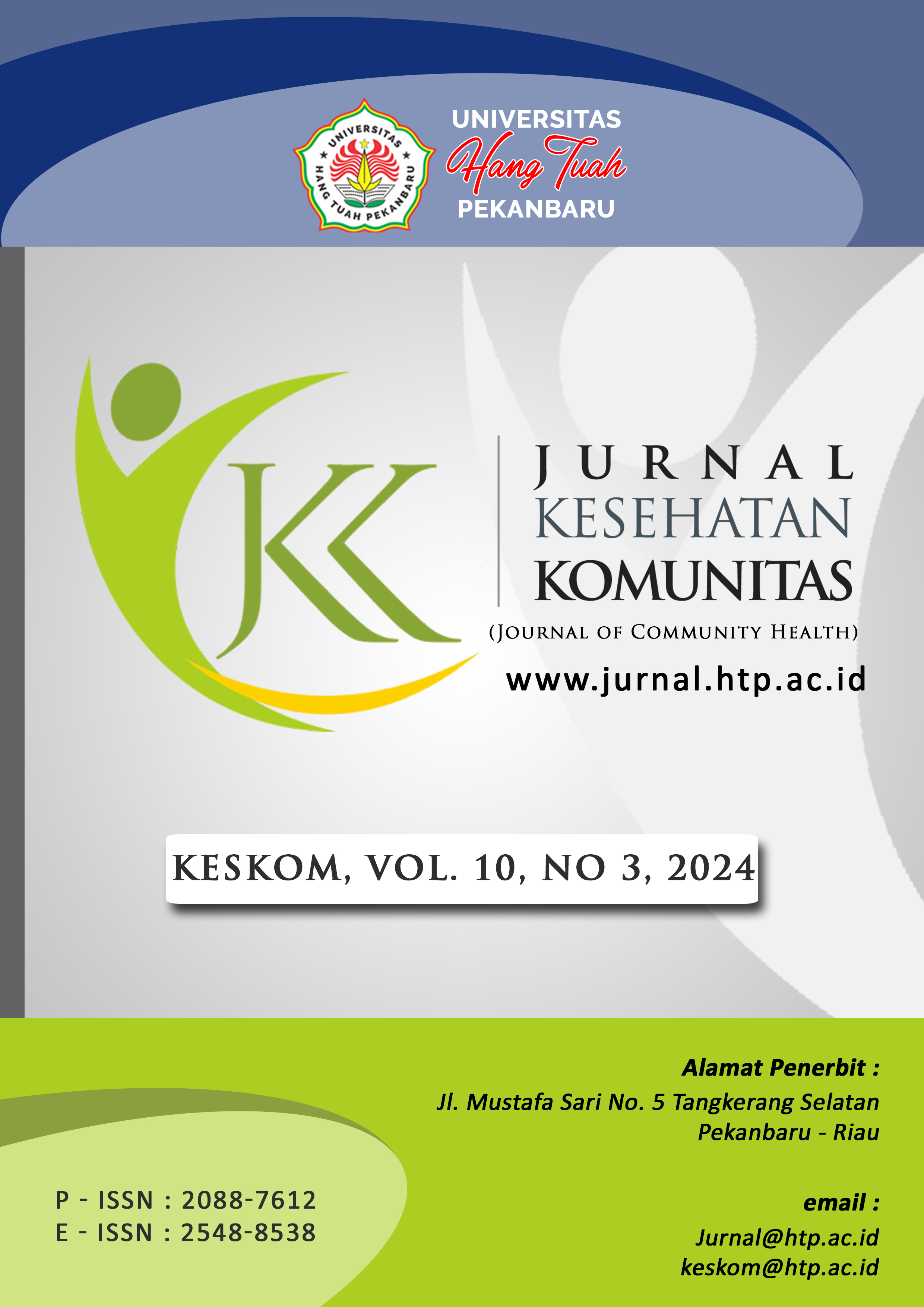Differences in Hepsidin Levels in Anemia and Non-anemia Adolescent Girls
DOI:
https://doi.org/10.25311/keskom.Vol10.Iss3.2090Abstract
Anemia affects 32% of Indonesian teenagers, which means that 3–4 out of 10 of them have the condition. Adolescent anemia will develop into pregnant anemia if it is not treated, which will affect the results for the mother and the newborn and could raise the chance of stunting. Before iron is distributed and stored as reserves (ferritin), hepcidin is a crucial hormone that controls systemic iron homeostasis. A test of hepcidin can distinguish between iron deficiency anemia and anemia of chronic disease. The purpose of this study is to examine the variations in hepcidin levels between teenage girls who are anemic and those who are not. This study uses a cross-sectional comparative approach and is of the observational analytical kind. Female students in their late teens attending Baiturrahmah University in Padang made up the study's sample. Requirements for inclusion include not having a history of diabetes mellitus, kidney illness, hemoglobinopathy, or smoking. Using a sequential sampling procedure, 36 individuals were selected, 18 of whom had anemia and the remaining 18 of whom did not. Hepcidin levels are derived from the outcomes of the ELISA method used to measure the serum hepcidin-25. The statistical test used is the Mann-Whitney test because the data is not normally distributed. The results showed that the average hepcidin level in the anemia group was lower than the hepcidin level in the non-anemia group (0,43±0,1 ng/ml vs 0,46±0,09 ng/ml. Statistical tests showed that there was no significant difference between hepcidin levels in the anemia group and the non-anemia group (p=0,43). The conclusion was that there was no significant relationship between hepcidin levels and anemia in adolescents. It is recommended that further research be conducted on hepcidin and other biomarkers that affect the action of hepcidin and the need to consider hepcidin testing in diagnosing anemia.
Downloads
References
1. Nurlaela Sari D, Mulyani Y, Ariani A. Dampak Pemberian Es Krim Buah Bit dan Jambu Biji Merah terhadap Kadar Haemoglobin Remaja Putri. J Kesehat komunitas (Journal community Heal. 2024;10(1):126–32.
2. Kemenkes. Hasil Utama Riset Kesehata Dasar (RISKESDAS) Tahun 2018 [Internet]. 2018. p. 1–200. Available from: http://arxiv.org/abs/1011.1669%0Ahttp://dx.doi.org/10.1088/1751-8113/44/8/085201%0Ahttp://stacks.iop.org/1751-8121/44/i=8/a=085201?key=crossref.abc74c979a75846b3de48a5587bf708f
3. WHO. Anaemia Policy Brief. 2014; Available from: http://www.who.int//iris/bitstream/10665/148556/1/WHO_NMH_NHD_14.4_eng.pdf
4. Aningsih TW, Fatah MZ. Literature Review : Hubungan Persepsi terhadap Konsumsi Tablet Tambah Darah Remaja Putri. 2024;7:230–3.
5. Kumalasari D, Kameliawati F, Mukhlis H, Krisatanti DA. Pola Menstruasi dengan Kejaidan Anemia pada Remaja. Wellness Heal Mag [Internet]. 2019;1(2):187–92. Available from: https://wellness.journalpress.id/wellness/article/view/v1i218wh
6. Khobibah K, Nurhidayati T, Ruspita M, Astyandini B. Anemia Remaja Dan Kesehatan Reproduksi. J Pengabdi Masy Kebidanan. 2021;3(2):11.
7. Pasalina PE, Ihsan HF, Devita H, Pasalina PE, Ihsan HF, Devita H, et al. Hubungan Riwayat Anemia Kehamilan dengan Kejadian Stunting pada Balita Relationship Between a History of Pregnancy Anemia and The Incidence of Stunting in Toddlers. 2023;12(2):267–71.
8. Bansal A, Sharma AK, Sharma S, Sujatha R. Iron Deficiency Anaemia in Women of Reproductive Age Group Attending a Tertiary Care Hospital. Indian J Sci Res. 2016;7(1):109–13.
9. Yunanci S, Risma R, Masrif M, Mulianingsih M. A Literature Review of the Relation Between Iron Deficiency Anaemia, Physical Activity and Cognitive Function in Adolescent Girls. Scr Medica (Banja Luka). 2023;54(4):405–12.
10. Zainury MI, Dasuki MS, Basuki SW. ANEMIA IN PREGNANT WOMEN AND MOTHERS EDUCATION LEVEL AS RISK FACTOR FOR STUNTING IN CHILDREN AGED 24-59 MONTHS IBU SEBAGAI FAKTOR RISIKO STUNTING PADA BALITA USIA 24-59 BULAN.
11. Kwapisz J, Slomka A, Zekanowska E. Hepcidin and Its Role in Iron Homeostasis. Ejifcc [Internet]. 2009;20(2):124–8. Available from: http://www.ncbi.nlm.nih.gov/pubmed/27683336%0Ahttp://www.pubmedcentral.nih.gov/articlerender.fcgi?artid=PMC4975279
12. Parajes S, González-Quintela A, Campos J, Quinteiro C, Domínguez F, Loidi L. Genetic study of the hepcidin gene (HAMP) promoter and functional analysis of the c.-582A > G variant. BMC Genet [Internet]. 2010;11(1):110. Available from: http://www.biomedcentral.com/1471-2156/11/110
13. Rishi G, Wallace DF, Subramaniam VN. Hepcidin: Regulation of the master iron regulator. Biosci Rep. 2015;35:1–12.
14. Naigamwalla DZ, Webb JA, Giger U. Review Article Iron deficiency anemia. Cvj. 2012;53(MARCH):250–6.
15. Manolov V, Marinov B, Velizarova M, Atanasova B, Vasilev V, Tzatchev K, et al. Anemia in pregnancy and serum hepcidin levels. Int J Adv resrarch. 2015;3(1):758–61.
16. Pasricha SR, McQuilten Z, Westerman M, Keller A, Nemeth E, Ganz T, et al. Serum hepcidin as a diagnostic test of iron deficiency in premenopausal female blood donors. Haematologica. 2011;96(8):1099–105.
17. Pasricha SR, Lim PJ, Duarte TL, Casu C, Oosterhuis D, Mleczko-Sanecka K, et al. Hepcidin is regulated by promoter-associated histone acetylation and HDAC3. Nat Commun [Internet]. 2017;8(1). Available from: http://dx.doi.org/10.1038/s41467-017-00500-z
18. Pagani A, Nai A, Silvestri L, Camaschella C. Hepcidin and Anemia: A Tight Relationship. Front Physiol. 2019;10(October):1–7.
19. Kanuri G, Chichula D, Sawhney R, Kuriakose K, De’Souza S, Pais F, et al. Optimizing diagnostic biomarkers of iron deficiency anemia in community-dwelling indian women and preschool children. Haematologica. 2018;103(12):1991–6.
20. Ilkovska B, Kotevska B, Trifunov G, Kanazirev B. Serum hepcidin reference range, gender differences, menopausal dependence and biochemical correlates in healthy subjects. J IMAB - Annu Proceeding (Scientific Pap. 2016;22(2):1127–31.
21. Zaman B, Rasool S, Jasim S, Abdulah D. Hepcidin as a diagnostic biomarker of iron deficiency anemia during pregnancy. J Matern Neonatal Med [Internet]. 2019;0(0):1–9. Available from: https://doi.org/10.1080/14767058.2019.1635112
22. Cairo RC de A, Silva LR, Bustani NC, Marques CDF. Anemia por deficiencia de hierro en adolescentes; una revision de la literatura. Nutr Hosp. 2014;29(6):1240–9.
23. Wibowo N, Rima I, Rabbania H. Anemia Defisiensi Besi Pada Kehamilan [Internet]. 2021. 411–415 p. Available from: https://www.pogi.or.id/wp-content/uploads/download-manager-files/Anemia Defisiensi Besi Pada Kehamilan.pdf
24. Bah A, Pasricha SR, Jallow MW, Sise EA, Wegmuller R, Armitage AE, et al. Serum hepcidin concentrations decline during pregnancy and may identify iron deficiency: Analysis of a longitudinal pregnancy cohort in the Gambia. J Nutr. 2017;147(6):1131–7.
25. Rahman RA, Fajar NA. Analisis Faktor Risiko Kejadian Anemia pada Remaja Putri: Literatur Review. J Kesehat komunitas (Journal community Heal. 2024;10(1):133–40.
26. Ikhtiyaruddin I, Alamsyah A, Mitra M, Setyaningsih A. Determinan Kejadian Anemia pada siswi Di SMAN 1 Teluk Belengkong Kabupaten Indragiri Hilir pada tahun 2019. J Kesehat Komunitas. 2020;6(1):56–62.
27. Adilah LH, Syafiq A, Sukoso S. Correlation of Anemia in Pregnant Women with Stunting Incidence: A Review. Indones J Multidiscip Sci. 2023;2(9):3155–69.
Downloads
Submitted
Accepted
Published
How to Cite
Issue
Section
License
Copyright (c) 2025 Jurnal kesehatan komunitas (Journal of community health)

This work is licensed under a Creative Commons Attribution-NonCommercial-ShareAlike 4.0 International License.
Copyright @2017. This is an open-access article distributed under the terms of the Creative Commons Attribution-NonCommercial-ShareAlike 4.0 International License (http://creativecommons.org/licenses/by-nc-sa/4.0/) which permits unrestricted non-commercial used, distribution and reproduction in any medium












































